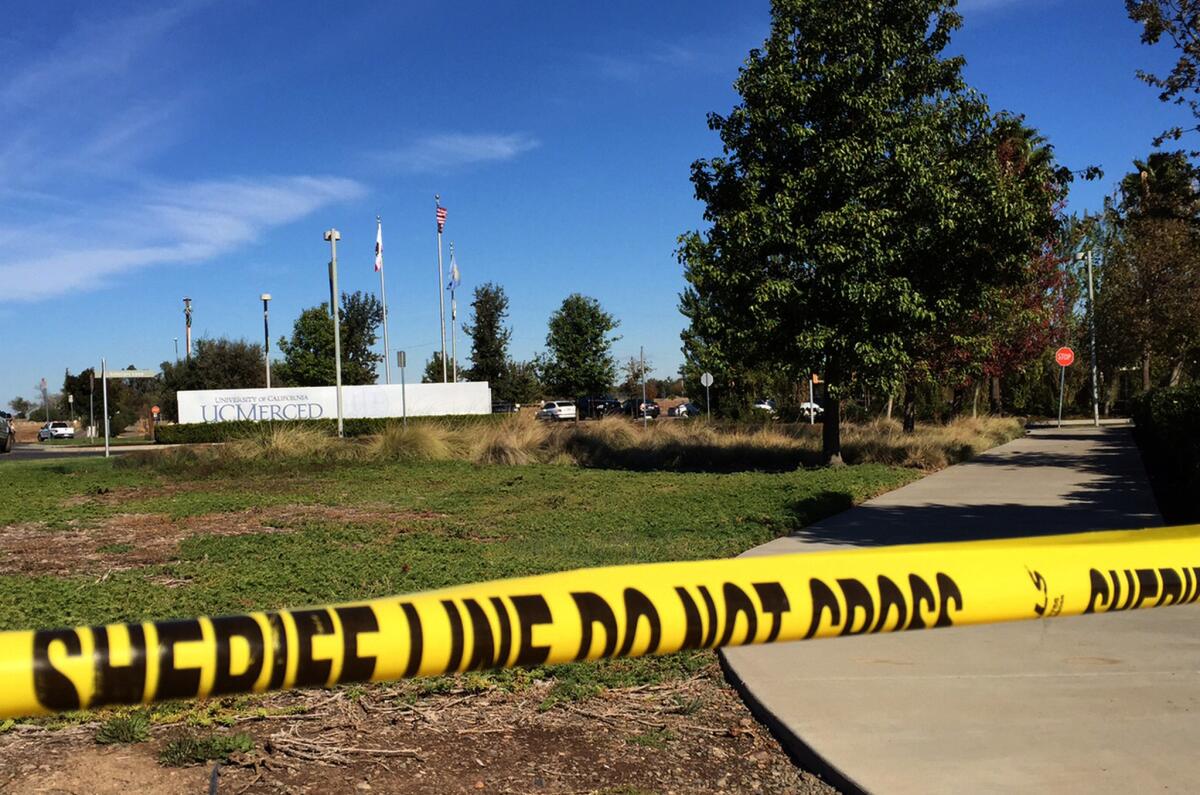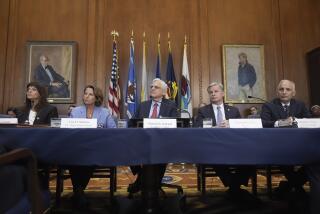How the White House is trying again to counter Islamic State propaganda

The scene outside UC Merced after 18-year-old freshman Faisal Mohammad stabbed four people in a knife attack in November.
Reporting from Washington â After FBI digital forensic experts broke into Faisal Mohammadâs laptop, they found that the 18-year-old was drawn to the flashy terrorist propaganda of Islamic State and âself-radicalizedâ before stabbing four people at UC Merced last fall.
The discovery announced Thursday, almost four months after the couple who gunned down 14 people in San Bernardino were found to be inspired by the extremist militants, is part of a trend that has confounded the Obama administration.
Now, the White House is again revamping its strategy to strike the Islamic State propaganda machine. It is launching a new counter-messaging center, enlisting the help of Silicon Valley and hunting recruiters and propaganda operatives on battlefields in Iraq and Syria.
See more of our top stories on Facebook >>
âThis is a very savvy group that treats the information battle space as important, if not more important, than the physical battle space,â Michael Lumpkin, President Obamaâs new counter-messaging chief, said in an interview. Islamic State is âa brand, so we need to treat it like a brand.â
Combating Islamic State online is the least developed and most controversial part of the administrationâs multi-pronged military strategy against the Islamic State, which includes daily airstrikes in Iraq and Syria, deployment of military advisors to assist Iraqi government and Kurdish forces, and attempts to choke off the militantsâ financing from oil sales and foreign donors.
Lumpkin, a 51-year-old retired Navy SEAL who directed the Pentagonâs response to the 2014 Ebola outbreak in West Africa, was named this week by presidential executive order to run the new Global Engagement Center.
The counter-messaging command hub is based on the second floor at the State Department and draws on information provided by the Pentagon, intelligence agencies, foreign allies and social media companies.
Instead of posting directly to social media itself, as the administration has tried, the center will provide money and expertise to nonprofit groups, foreign governments and Muslim activists overseas to help craft and post their own material intended to counter the allure of jihad.
The center will also leverage analytics to track social media accounts and to pinpoint so-called fence sitters, who are leaning toward radicalism, and target them directly. The collected information will be passed along to nonprofits or other Muslim groups, who can intervene directly through public or private messaging to refute Islamic Stateâs twisted view of Islam and injustice.
Mohammad, a freshman at UC Merced, began preparing for the Nov. 4 rampage at least one week beforehand, the FBI said. No information was found that showed he was helped or directed by another person or group in carrying out the stabbings, the agency said, but his laptop contained pro-Islamic State propaganda, and he visited extremist websites in the weeks prior to his attack.
A campus police officer trying to stop the attack shot Mohammad to death. On Friday, the university chancellor said the school community was relieved the investigation was over and ready to move on.
Investigators found a photocopy of the black Islamic State flag in Mohammadâs backpack along with a two-page, handwritten plan detailing his intentions, including taking hostages and killing students and police officers.
U.S. intelligence agencies are increasingly seeing such attacks carried out by small cells or lone actors who watch propaganda videos and self-radicalize â âdo-it-yourself terrorism,â Lisa Monaco, Obamaâs senior counter-terrorism advisor, said last week at the nonpartisan Council on Foreign Relations in Washington.
âMany of these recruits have been middle class and seemingly well-adjusted in their communities,â she said.
âThe FBI has investigated ISIL-inspired suspects in all 50 states,â she said, using an acronym for Islamic State. âAnd this is not just an American or a Western problem â as weâve seen from Nigeria to Indonesia, this is a global problem.â
NEWSLETTER: Get the dayâs top headlines from Times Editor Davan Maharaj >>
The White House was caught flat-footed and slow to react to Islamic Stateâs propaganda campaign, said Alberto Fernandez, who led the forerunner to the Global Engagement Center, called the Center for Strategic Counterterrorism Communications, from March 2012 to February 2015.
That operation was established in 2011 to coordinate counter-messaging against Al Qaeda and other extremist groups. Back then, Osama bin Laden attempted to recruit and rally followers with hour-long videotaped sermons from remote caves â tactics that now seem as dated as black-and-white TV.
When Islamic State swept into Iraq from Syria during the spring of 2014, it began posting short films online complete with slick jump-cuts and soundtracks. It also had recruiters on social media at all times of the day, trying to lure new followers.
The U.S. governmentâs work on social media looked second-rate by comparison. It tried to compete by posting a minute-long YouTube video entitled âWelcome to ISIS Land,â using another acronym for Islamic State. The video depicted severed heads, crucifixions, and other executions that the militants had carried out and was widely disparaged for being overtly violent and corny.
âEverything we did was on the cheap,â Fernandez said. âISIS started a propaganda arms race and they were winning⌠The legacy of ISIS will not be their use of violence. It will be their use of social media, which has forced all other terror groups to step up their games.â
White House National Security Council spokesman Emily Horne acknowledged the administrationâs initial strategy responding to Islamic Stateâs messaging blitz wasnât successful and needed to change.
âOne of the important things we have learned is that the U.S. government is not necessarily the best communicator on these issues for the most vulnerable audiences that we most need to reach,â she said.
Unable to compete online, the Pentagon has also tried to wipe out the propagandists.
U.S. warplanes bombed seven facilities Wednesday near Mosul, Iraq, that the Pentagon said were used to produce Islamic State propaganda. And in August, a U.S. drone strike near Raqqah, Syria, killed Junaid Hussain, a British-born propagandist and hacker, who had posted the names, addresses and photos of about 1,300 U.S. military and other officials online and urged followers to attack them.
U.S. Cyber Command, which is responsible for U.S. offensive operations in cyberspace, has also targeted some computer networks and social media accounts.
But stopping that communication has proved an immense challenge, which is why the administration has enlisted Facebook, YouTube, Twitter and other social media and tech companies to block material used to recruit and radicalize online.
Facebook deletes pages or posts from any person or group who posts terrorist material, said Monika Bickert, a company executive. The company also passes tips to the government when an anti-terrorism post goes viral, showing its appeal.
Twitter, which also has a zero-tolerance policy for pro-terrorist tweets, said it had suspended more than 125,000 accounts.
Campaigns looking to compete with Islamic State online can be ineffective, though, because the militants are seeking fellow zealots, not broad Muslim support, said William McCants, an expert on Islamic extremism at the Brookings Institution, a nonpartisan think tank.
They are trying âto polarize Muslims and recruit from the tiny minority who get excited about its messages,â he said. âItâs hard to see how any counter-message -- no matter how well-crafted or well-researched -- could make ISIS any more unpopular. It doesnât matter who the messenger is or how much money they have.â
Times staff writers Joseph Serna and Matt Hamilton contributed to this report.
Twitter: @wjhenn
ALSO
U.S. declares Islamic State atrocities as âgenocideâ
European Union and Turkey reach deal on migrant crisis, officials say
French president says latest arrest in Paris attacks does not mean search for suspects is over
More to Read
Sign up for Essential California
The most important California stories and recommendations in your inbox every morning.
You may occasionally receive promotional content from the Los Angeles Times.











